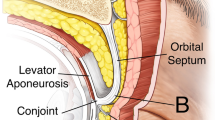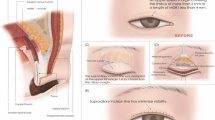Abstract
To achieve fewer hematomas in upper blepharoplasty, I use a monopolar cutting cautery unit. Ice compresses are used intraoperatively, and a tapered needle prevents orbicularis bleeding with closure.
Access provided by Autonomous University of Puebla. Download chapter PDF
Similar content being viewed by others
Keywords
The following text and photos illustrate how I perform upper blepharoplasty surgery. The settings are specific to the ERBE ICC 80 unit and may not be directly transferable to another brand of electrosurgery unit.
-
1.
Carefully adjust monopolar cutting cautery settings for each step (“Effect 2” setting used throughout).
-
2.
Use a fine needle tip, such as a Colorado® needle or equivalent clone.
-
3.
Continuously ice the side you are not working on (Fig. 32.1).
-
4.
Skin incision cutting mode 7. Incise gently and smoothly to avoid excess heat (Fig. 32.2).
-
5.
Skin–muscle flap excision, coagulation mode 10 (Fig. 32.3).
-
6.
ROOF fat sculpting, coagulation mode 15 (Fig. 32.4).
-
7.
Hemostats are used to hold gauze that secures ice over each eye (Fig. 32.5). This prevents ice from falling. Only the lower hemostat is moved to switch eyes.
-
8.
Use of a tapered needle prevents orbicularis bleeding with closure (Fig. 32.6).
-
9.
Early postoperative photos (Fig. 32.7).
Author information
Authors and Affiliations
Corresponding author
Editor information
Editors and Affiliations
Rights and permissions
Copyright information
© 2015 Springer Science+Business Media New York
About this chapter
Cite this chapter
Devoto, M.H. (2015). Fewer Hematomas in Upper Blepharoplasty. In: Hartstein, MD, FACS, M., Massry, MD, FACS, G., Holds, MD, FACS, J. (eds) Pearls and Pitfalls in Cosmetic Oculoplastic Surgery. Springer, New York, NY. https://doi.org/10.1007/978-1-4939-1544-6_32
Download citation
DOI: https://doi.org/10.1007/978-1-4939-1544-6_32
Published:
Publisher Name: Springer, New York, NY
Print ISBN: 978-1-4939-1543-9
Online ISBN: 978-1-4939-1544-6
eBook Packages: MedicineMedicine (R0)











